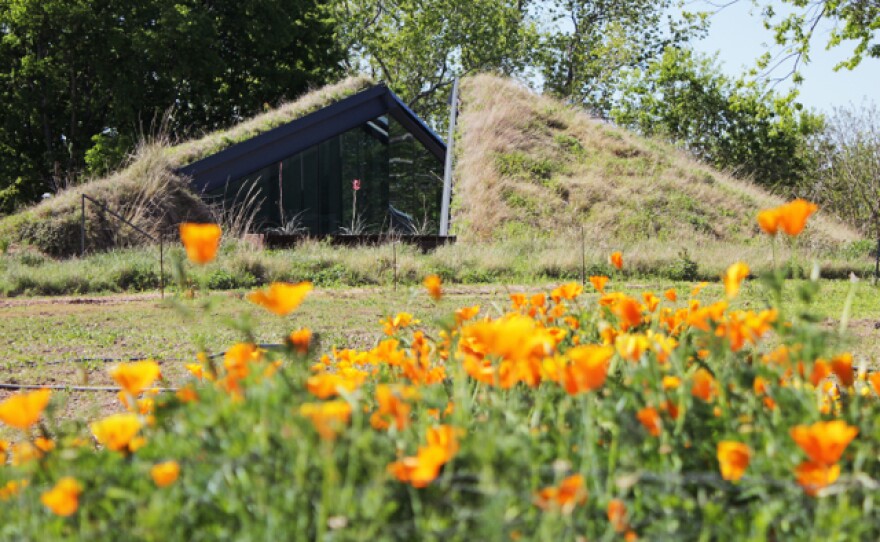In Austin, a group of architects and ecologists have created a house and landscape design that celebrates the unique climate, living species, and cultural traditions of Central Texas.
It’s perched on an east Austin bluff overlooking the Colorado River, on a reclaimed industrial site. KUT’s Cathy Byrd toured the home, called Edgeland House, with architect Thomas Bercy, of Bercy Chen Studio, and ecologist Mark Simmons, director of the Ecosystem Design Group for the Lady Bird Johnson Wildflower Center.
KUT: Thomas Bercy – What’s the philosophy behind the design?
Thomas Bercy: We were influenced by a certain ancient type of first native Indian sedentary dwelling: the pit house, a half-buried structure with framing and grass roof above.
KUT: Since the project is between an industrial zone and the river, how difficult was it for you to achieve a balance between those two systems, or environments?
Bercy: I think this is kind of an amazing site. We’re close to downtown, yet we’ve got about two and a half acres of space. And I think there’s an interesting aspect of topography that’s changing. So it’s a sloping site that allowed us to bury the back of the lot and achieve perfect privacy from the street, but open up the back of the house to the view.
KUT: Mark Simmons – What was your goal with the landscaping?
Mark Simmons: Well, it was partly speaking with the architect and the client. What they really wanted here was a native landscape, and one that enveloped and wrapped around the residence like a shroud. Really this is the perfect canvas for doing something like this.
KUT: Where in this design do you address the flora and ecology of Central Texas?
Simmons: What we do with all our design is based on performance – what you want the landscape to do.
There are a number of things here, outside the native ecology. But essentially what we do when we make the plant selection is we say, well, we’ve already tested the plants that we know will grow on the roof.
But of course, the flora of Texas is huge. We’ve got about five and half thousand vascular species. So, we’ve got a big palette to choose from. So we decided, let’s go with the ones we know will grow on the roof – the ones that should be dominant on a Texas prairie. And then pick out the flowers which are going to be the show-iest at different times of the year. The whole thing in the end is to get as rich a native habitat as possible.
Bercy: The benefit outweighs the challenges. You know we live in cities and you are several degrees hotter within the cities than outside the cities. This is going to be mitigated by this green roof. These runoffs are substantial in a place like Texas. It’s this drought-flood cycle.
There are also aspects of sustainability that are interesting such as much higher insulation value. And then, probably one of the most important aspects is that we’re able to bring this flora and fauna back into our cities on top of our roofs and be much more sensible ecologically.
Simmons: From the research done at the Wildflower Center, where a normal, say, black roof or flat roof would be 170 degrees on an August afternoon, on a green roof, it’s down in the 90s. You can see you’re really reducing that thermal loading on the roof.
KUT: What eco-system have you built with the roof?
Simmons: This ecosystem is really a representation of a Blackland Prairie. Now remember, Blackland Prairie used to have 20 million acres in Texas, and there’s only a few thousand left.
So, this is one way to bring the Prairie’s ecological function back to Austin. You imagine you could translate this across roofs and backyards across Austin. This could become the largest preserve of Blackland Prairie scattered across the city.






